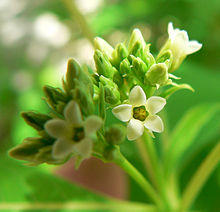| Apocynaceae | |
|---|---|

| |
| Apocynum cannabinum | |
| Scientific classification | |
| Kingdom: | Plantae |
| Clade: | Tracheophytes |
| Clade: | Angiosperms |
| Clade: | Eudicots |
| Clade: | Asterids |
| Order: | Gentianales |
| Family: | Apocynaceae Juss. |
| Type genus | |
| Apocynum | |
| Synonyms | |
Apocynaceae (/əˌpɑːsəˈneɪsiˌaɪ, -siːˌiː/, from Apocynum, Greek for "dog-away") is a family of flowering plants that includes trees, shrubs, herbs, stem succulents, and vines, commonly known as the dogbane family,[1] because some taxa were used as dog poison.[when?][2] Members of the family are native to the European, Asian, African, Australian, and American tropics or subtropics, with some temperate members.[1] The former family Asclepiadaceae (now known as Asclepiadoideae) is considered a subfamily of Apocynaceae and contains 348 genera. A list of Apocynaceae genera may be found here.
Many species are tall trees found in tropical forests, but some grow in tropical dry (xeric) environments. Also perennial herbs from temperate zones occur. Many of these plants have milky latex, and many species are poisonous if ingested, the family being rich in genera containing alkaloids and cardiac glycosides, those containing the latter often finding use as arrow poisons. Some genera of Apocynaceae, such as Adenium, bleed clear sap without latex when damaged, and others, such as Pachypodium, have milky latex apart from their sap.
- ^ a b Endress ME, Bruyns PV (2000). "A revised classification of the Apocynaceae s.l." (PDF). The Botanical Review. 66 (1): 1–56. Bibcode:2000BotRv..66....1E. doi:10.1007/BF02857781. S2CID 31739212.
- ^ Cite error: The named reference
Simpsonwas invoked but never defined (see the help page).